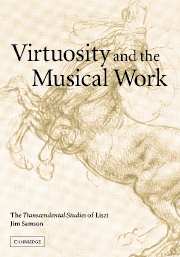6 - Suggestion and symbol
Published online by Cambridge University Press: 22 September 2009
Summary
FROM TOPICS TO TITLES
One significant indicator of an early nineteenth-century expressive aesthetic is the expanded range of expression marks utilised by composers in their instrumental works, as though they sought to make as specific as possible the poetic content of a work in the absence of title or programme. Thus, the Grandes Etudes parade the following, among many others: energico vibrante, tumultuoso, radolcendo, lamentevole, delirando, disperato, incalzando, and presto feroce. Significantly, most of these markings were removed by Liszt when the etudes were revised in 1851, no doubt partly to signal that the emotional temperature of the music had been lowered by just a notch in the interests of formal coherence, but also because something of the signifying role of expression marks could now be assumed by the newly assigned titles. Another instance of this is the removal of the term patetico, with its semi-programmatic resonance, from the openings of both the fourth and the sixth etudes, once the titles had been assigned. Thus, Allegro patetico became Allegro in Mazeppa, and Largo patetico became Lento in Vision. What all this raises is the vexed question of the status of titles in Liszt's etudes, and in his music generally. For one thing, the titles assigned to most of the etudes are rather non-specific, indicative of generalised moods and settings rather than particular narrative or pictorial themes. And for another, his attitude to the assignation of specific titles to specific pieces was, as I will shortly demonstrate, somewhat permissive.
- Type
- Chapter
- Information
- Virtuosity and the Musical WorkThe Transcendental Studies of Liszt, pp. 175 - 197Publisher: Cambridge University PressPrint publication year: 2003



